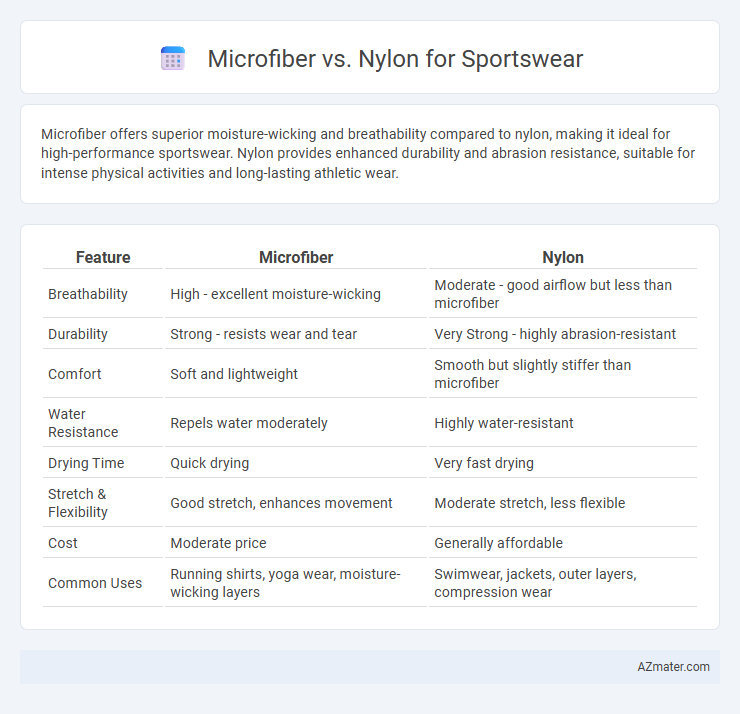Microfiber offers superior moisture-wicking and breathability compared to nylon, making it ideal for high-performance sportswear. Nylon provides enhanced durability and abrasion resistance, suitable for intense physical activities and long-lasting athletic wear.
Table of Comparison
| Feature | Microfiber | Nylon |
|---|---|---|
| Breathability | High - excellent moisture-wicking | Moderate - good airflow but less than microfiber |
| Durability | Strong - resists wear and tear | Very Strong - highly abrasion-resistant |
| Comfort | Soft and lightweight | Smooth but slightly stiffer than microfiber |
| Water Resistance | Repels water moderately | Highly water-resistant |
| Drying Time | Quick drying | Very fast drying |
| Stretch & Flexibility | Good stretch, enhances movement | Moderate stretch, less flexible |
| Cost | Moderate price | Generally affordable |
| Common Uses | Running shirts, yoga wear, moisture-wicking layers | Swimwear, jackets, outer layers, compression wear |
Introduction to Sportswear Fabrics
Microfiber and nylon are two prominent fabrics used in sportswear, each offering unique performance benefits. Microfiber, composed of ultra-fine synthetic fibers, excels in moisture-wicking and breathability, making it ideal for high-intensity activities. Nylon provides exceptional durability, elasticity, and resistance to abrasion, ensuring longevity and flexibility during rigorous workouts.
What is Microfiber?
Microfiber is a synthetic fiber typically made from a blend of polyester and polyamide, designed to be finer than natural fibers, which enhances its softness and breathability. Its ultra-fine threads create a lightweight, moisture-wicking fabric that excels in sportswear for quick drying and temperature regulation. Microfiber's superior durability and resistance to shrinking and stretching make it ideal for high-performance activewear compared to traditional nylon.
What is Nylon?
Nylon is a synthetic polymer known for its strength, elasticity, and resistance to abrasion, making it a popular choice for sportswear. Its moisture-wicking properties and quick-drying abilities help keep athletes comfortable during intense physical activities. Compared to microfiber, nylon offers superior durability while maintaining lightweight flexibility essential for high-performance sports gear.
Moisture-Wicking Capabilities
Microfiber excels in moisture-wicking due to its fine synthetic fibers that quickly draw sweat away from the skin, enhancing breathability and promoting faster evaporation. Nylon, while durable and lightweight, tends to absorb more moisture, making it less efficient at keeping athletes dry during intense workouts. Choosing microfiber sportswear significantly improves comfort by maintaining dryness and preventing chafing in high-performance environments.
Breathability and Comfort
Microfiber sportswear offers superior breathability due to its fine fibers that allow better air circulation and moisture-wicking properties, keeping athletes dry and comfortable during intense workouts. Nylon, while durable and stretchy, tends to retain more heat and moisture, which may reduce ventilation and comfort in high-sweat conditions. Choosing microfiber fabric enhances overall comfort by promoting faster evaporation of sweat and improved airflow compared to nylon alternatives.
Durability and Longevity
Microfiber sportswear offers superior durability due to its tightly woven synthetic fibers that resist wear and tear, making it ideal for intense athletic activities. Nylon is also known for its strength and abrasion resistance but may degrade faster than microfiber when exposed to repeated washing and UV exposure. Choosing microfiber ensures longer-lasting sportswear performance and maintains fabric integrity over extended use.
Weight and Flexibility
Microfiber sportswear typically offers superior lightweight properties, enhancing breathability and reducing overall garment weight for peak athletic performance. Nylon, while slightly heavier, provides exceptional flexibility and durable stretch, accommodating a wider range of motion during intense physical activity. Choosing between microfiber and nylon depends on prioritizing ultra-lightweight comfort or robust elastic support in sportswear design.
Odor Resistance
Microfiber sportswear offers superior odor resistance compared to nylon, as its dense fibers effectively wick moisture away from the skin, reducing bacterial growth that causes odors. Nylon, while durable and quick-drying, tends to retain sweat and odor more easily due to its less breathable structure. Athletes seeking odor-resistant apparel often prefer microfiber for prolonged freshness during intense workouts.
Environmental Impact
Microfiber sportswear, often made from polyester, sheds tiny plastic fibers during washing, contributing significantly to microplastic pollution in waterways. Nylon production consumes substantial energy and water, releasing nitrous oxide, a potent greenhouse gas, impacting climate change adversely. Choosing recycled nylon or advanced microfiber recycling technologies helps reduce the environmental footprint of sportswear materials.
Choosing the Right Fabric for Your Sport
Microfiber and nylon are both popular fabrics for sportswear, with microfiber excelling in moisture-wicking and breathability, making it ideal for high-intensity activities like running or cycling. Nylon offers exceptional durability and abrasion resistance, preferred for sports that require ruggedness such as rock climbing or hiking. Selecting the right fabric depends on the sport's demands: microfiber for lightweight comfort and quick dry, nylon for toughness and long-lasting performance.

Infographic: Microfiber vs Nylon for Sportswear
 azmater.com
azmater.com